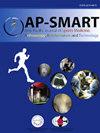钢丝与钩钢板治疗肩锁关节脱位的比较meta分析
IF 1.4
Q3 ORTHOPEDICS
Asia-Pacific Journal of Sport Medicine Arthroscopy Rehabilitation and Technology
Pub Date : 2025-05-10
DOI:10.1016/j.asmart.2025.04.001
引用次数: 0
摘要
目的本研究旨在比较钢丝绳系统与钩钢板内固定治疗III-VI级急性肩锁关节脱位的临床和影像学结果。方法检索PubMed、Cochrane和谷歌Scholar,检索时间为2017年1月至2023年12月。该研究的主要重点是评估各种因素,如恒定评分、加州大学洛杉矶分校(UCLA)肩部评分、视觉模拟量表(VAS)、喙锁骨距离(CCD)和并发症发生率。分析包括确定加权平均差(WMD)及其相应的95%置信区间(95% ci),或95% ci的风险比(RR),以量化收集到的数据。结果共纳入8项研究,484名受试者。各组之间的Constant-Murley评分差异有统计学意义。然而,在UCLA评分、VAS评分或CCD改善方面没有发现差异。亚组分析也得出了一致的结果。结论两种治疗方式在缓解疼痛、增强肩锁关节功能、矫正喙锁关节距离方面具有相似的临床和影像学疗效。然而,TightRope系统显示出额外的优势,包括降低再手术率和降低肩峰下锁骨远端骨溶解的风险。本文章由计算机程序翻译,如有差异,请以英文原文为准。
Comparative meta-analysis of TightRope vs. hook plate for acromioclavicular joint dislocation
Objective
This study aims to compare the clinical and radiographic outcomes of the tight-rope system versus internal fixation with a hook plate for treating grade III-VI acute acromioclavicular dislocation.
Methods
Relevant studies were identified by searching PubMed, Cochrane, and Google Scholar, from January 2017 to December 2023. The primary focus of the study revolved around evaluating various factors such as the Constant Score, University of California Los Angeles (UCLA) Shoulder Score, Visual Analogue Scale (VAS), coracoclavicular distance (CCD), and incidences of complications. The analysis involved determining the weighted mean difference (WMD) along with its corresponding 95 % confidence intervals (95 % CIs), or risk ratios (RR) with 95 % CIs to quantify the collected data.
Results
Eight studies comprising 484 participants were included. Significant differences were observed in the Constant-Murley score between groups. However, no disparities were found in UCLA scores, VAS scores, or CCD improvement. Subgroup analyses also yielded consistent results.
Conclusions
Both treatment modalities demonstrated similar clinical and radiographic efficacy in alleviating pain, enhancing acromioclavicular joint function, and correcting coracoclavicular distance. Nevertheless, the TightRope system exhibited additional advantages, including reduced reoperation rates and lower risk of subacromial distal clavicle osteolysis.
求助全文
通过发布文献求助,成功后即可免费获取论文全文。
去求助
来源期刊
CiteScore
3.80
自引率
0.00%
发文量
21
审稿时长
98 days
期刊介绍:
The Asia-Pacific Journal of Sports Medicine, Arthroscopy, Rehabilitation and Technology (AP-SMART) is the official peer-reviewed, open access journal of the Asia-Pacific Knee, Arthroscopy and Sports Medicine Society (APKASS) and the Japanese Orthopaedic Society of Knee, Arthroscopy and Sports Medicine (JOSKAS). It is published quarterly, in January, April, July and October, by Elsevier. The mission of AP-SMART is to inspire clinicians, practitioners, scientists and engineers to work towards a common goal to improve quality of life in the international community. The Journal publishes original research, reviews, editorials, perspectives, and letters to the Editor. Multidisciplinary research with collaboration amongst clinicians and scientists from different disciplines will be the trend in the coming decades. AP-SMART provides a platform for the exchange of new clinical and scientific information in the most precise and expeditious way to achieve timely dissemination of information and cross-fertilization of ideas.

 求助内容:
求助内容: 应助结果提醒方式:
应助结果提醒方式:


